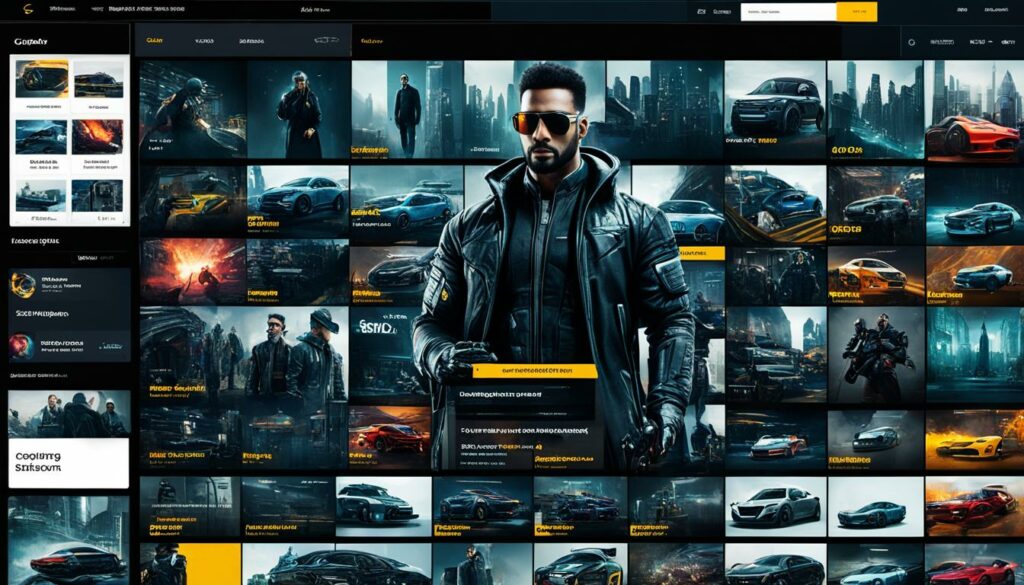Welcome to the world of multimedia-rich content hosting! In today’s digital landscape, incorporating engaging multimedia such as images and videos is crucial for creating an impactful online presence. Whether you’re a blogger, a business owner, or a content creator, understanding the best practices for hosting multimedia content is key to delivering a seamless user experience and optimizing your website for search engines.
In this article, we will explore the top practices for hosting multimedia-rich content, helping you make an informed decision for your website. From ensuring reliable and secure media delivery to optimizing images and videos for improved SEO performance, we’ll cover all the essential aspects to help your multimedia content shine.
Key Takeaways:
- Choose a reliable and secure multimedia hosting service provider to ensure smooth media delivery.
- Rich media, such as images and videos, play a crucial role in improving SEO and user engagement.
- Blended results in search engines can make your webpages more appealing and visible to users.
- Optimize images by using the WebP format, providing descriptive ALT attributes, and optimizing file sizes.
- Video optimization involves choosing compatible formats, considering autoplay options, and optimizing page load speed.
Now that you have a glimpse of what this article has in store, let’s dive deeper into the exciting realm of multimedia content hosting and discover how it can elevate your online presence.
Why Rich Media is Important for SEO
Rich media, including images and videos, plays a vital role in boosting your website’s SEO and improving search engine rankings. Incorporating engaging multimedia content, also known as engagement objects, not only enhances user experience but also increases user engagement, ultimately leading to better visibility in search results.
When it comes to SEO, images and videos offer several advantages. They attract the attention of users, encourage them to spend more time on your website, and provide valuable information in an engaging format. By effectively utilizing rich media, you can optimize your website for maximum search engine visibility.
By using images and videos, you can create visually appealing content that captures the interest of your audience. These forms of rich media enable you to convey your message in a compelling manner, resulting in better engagement and higher conversion rates.
Search engines value rich media content because it enhances the overall user experience. When users interact with multimedia elements on your site, they are more likely to stay longer, explore different pages, and view multiple pieces of content. This extended dwell time indicates to search engines that your website provides valuable information and is deserving of higher rankings.
In addition to user experience, rich media also helps search engine crawlers understand your content better. By providing descriptive ALT attributes for images and optimizing video metadata, you can enhance the visibility and relevance of your multimedia content in search results.
Moreover, incorporating engagement objects like infographics, interactive maps, and embedded social media posts can further enrich your website’s content and encourage user interaction. These elements not only improve SEO but also increase the chances of your content being shared and linked to by others, thus boosting your website’s authority and credibility.
Benefits of Rich Media for SEO:
- Enhances user experience and engagement
- Improves search engine visibility and rankings
- Increases dwell time on your website
- Attracts more organic traffic
- Enhances content relevance and understanding
- Increases the likelihood of content sharing and linking
Example of engagement objects:
- Infographics
- Videos
- Interactive maps
- Embedded social media posts
The Benefits of Rich Media in Search Results
Incorporating rich media, such as videos and images, into your content can have numerous advantages in search results. Let’s explore how these multimedia elements can enhance the visibility and appeal of your webpages.
1. Blended Results
Blended results are search engine results pages (SERPs) that feature a mix of different content types, including text, images, videos, and more. By including multimedia-rich content, you can make your webpages more enticing to both search engines and users. With blended results, your content has a better chance of standing out and attracting clicks.
2. Increased Visibility in Web and Video Searches
Hosting videos on your website offers a twofold benefit. Firstly, it can improve your visibility in web searches, making it more likely for your website to appear in search engine results. Secondly, by optimizing your video content, you can increase visibility in video searches conducted on platforms like YouTube.
According to recent studies, videos are more likely to appear on the first page of search results. By producing engaging and relevant video content, you can increase your chances of being discovered by users searching for multimedia-rich information.
3. Independent Ranking in Image Searches
High-quality images can also contribute to your website’s visibility. When properly optimized, images have the potential to rank on their own in image search results. This provides an additional opportunity for your website to be found by users looking specifically for visual content.
To make the most of this benefit, ensure that your images are properly labeled, with descriptive alt tags and relevant file names. Additionally, optimize image file sizes to improve page load times, enhancing both user experience and search engine optimization.

How to Optimize Images for SEO
Optimizing images is crucial for improving your website’s SEO performance and enhancing the user experience. By following best practices for image optimization, you can ensure optimal performance, faster page load times, and better search engine rankings.
Use the WebP Format
One effective way to optimize your images is by using the WebP format. WebP is a modern image format that provides high-quality compression, resulting in smaller file sizes without sacrificing image quality. By using WebP, you can significantly reduce the size of your images, leading to faster load times and improved SEO.
Incorporate Descriptive ALT Attributes
Another important aspect of image optimization is the use of descriptive ALT attributes. ALT attributes provide alternative text that is displayed when an image cannot be loaded or accessed. Including relevant keywords in your ALT attributes can help search engines understand the context of your images and improve their visibility in search results.
Specify Height and Width Dimensions
When adding images to your website, it’s essential to specify the height and width dimensions. This allows the browser to allocate the necessary space for each image, preventing layout shifts and reducing page load times. By providing these dimensions, you can create a smoother user experience and optimize your website for SEO.
Avoid Using Large Images
Using large images can significantly impact page load times and negatively affect user experience. It’s important to resize and compress your images appropriately before uploading them to your website. By reducing the file size of your images without compromising quality, you can ensure faster page load times and better overall performance.
Implementing these image optimization best practices, including using the WebP format, incorporating descriptive ALT attributes, specifying height and width dimensions, and avoiding large images, can greatly improve your website’s SEO and provide a seamless user experience.

| Benefits | Best Practices |
|---|---|
| Improved search engine rankings | Use WebP format |
| Faster page load times | Incorporate descriptive ALT attributes |
| Enhanced user experience | Specify height and width dimensions |
| Avoid using large images |
Best Practices for Video Optimization
Video optimization plays a crucial role in improving your website’s SEO performance. By following best practices, you can enhance user engagement, increase dwell time, and create a strong branding activity. Here are some key considerations for optimizing videos:
- Choose compatible video formats: Use video formats that are compatible with different devices and platforms to ensure seamless playback and accessibility for your audience.
- Utilize autoplay with muted audio: Autoplay videos can capture users’ attention and enhance engagement. However, make sure to mute the audio to provide a pleasant browsing experience.
- Optimize page load speed: Page load speed is critical for user satisfaction and SEO. Optimize your videos to load quickly and efficiently, minimizing any delays that can lead to user frustration and increased bounce rates.
- Create a compelling thumbnail and title: A visually appealing thumbnail and an enticing title can attract users to click and watch the video. Invest time in designing eye-catching thumbnails that accurately represent the video content.
Remember, a well-optimized video can significantly improve your website’s SEO performance, increase user engagement, and boost your overall online presence.
Example:
“Video optimization has been a game-changer for our website. By using autoplay videos with muted audio, we’ve seen a significant increase in user engagement and dwell time. The seamless playback and fast load times have positively impacted our SEO performance, resulting in higher search engine rankings.” – Jane Smith, Digital Marketer
Benefits of Video Optimization:
| Benefits | Explanation |
|---|---|
| Increased dwell time | Engaging videos keep users on your website for longer periods, positively affecting dwell time.. |
| Enhanced user engagement | Autoplay videos capture users’ attention and encourage them to interact with your content. |
| Effective branding activity | Well-optimized videos can act as a strong branding tool, conveying your brand message and values. |
| Improved SEO performance | Optimized videos contribute to a better user experience, leading to higher search engine rankings. |
Ensuring an SEO-Friendly Multimedia Hosting Environment
When it comes to hosting multimedia content, creating an SEO-friendly environment is essential to optimize your website’s performance and improve search engine rankings. By adhering to specific content requirements, managing file sizes, and minimizing the impact of cookies and HTTP calls, you can create a lean and efficient hosting environment for your multimedia content.
Content Requirements
To ensure seamless integration and compatibility with your multimedia content, it’s important to follow specific content requirements:
- Use the correct ad sizes to maintain a visually appealing layout.
- Follow asset requirements to ensure smooth playback and interaction with your multimedia content.
- Support a wide range of file types to accommodate different formats and devices.
File Size Optimization
Optimizing file sizes is crucial for improving not only the performance of your website but also its impact on SEO:
- Keep file sizes optimized to reduce page load times and provide a better user experience.
- Avoid using large multimedia files that can significantly slow down your website’s loading speed.
- Compress multimedia files without compromising their quality to strike a balance between performance and visual appeal.
Minimizing Cookies and HTTP Calls
Limiting the number of cookies and HTTP calls made by your multimedia content can help maintain a lean and efficient hosting environment:
- Minimize the use of cookies to reduce the amount of data stored and exchanged between the user’s browser and your website.
- Optimize HTTP calls to ensure efficient communication between your website and the server hosting the multimedia content.
By following these practices, you can create an SEO-friendly hosting environment for your multimedia content, improving website performance, user experience, and search engine rankings.

Conclusion
Incorporating multimedia content into your website is a powerful strategy for enhancing user engagement and improving search engine rankings. By following best practices for hosting multimedia-rich content, optimizing images and videos, and creating an SEO-friendly hosting environment, you can maximize the impact of your online presence.
When hosting multimedia content, make sure to consider factors such as reliability, security, and fast media delivery. Choose hosting providers that specialize in multimedia content hosting and offer reliable and affordable solutions. This will ensure that your multimedia content is readily available to your audience and contributes to a positive user experience.
In addition, optimize your images by using the correct file format, including descriptive ALT attributes, and optimizing image size. This will not only improve your website’s SEO but also enhance page load times, contributing to a seamless user experience. Similarly, optimize your videos by using compatible formats, considering autoplay options, and optimizing for fast loading times. These practices will increase user engagement and dwell time on your website, further boosting its search engine rankings.
To maintain an SEO-friendly hosting environment, ensure that your content meets requirements such as ad sizes, asset requirements, and supported file types. Keep file sizes optimized, limit cookies, and minimize HTTP calls to create a lean and efficient hosting environment for your multimedia content. By following these best practices, you can strengthen your overall SEO strategy and achieve a higher visibility for your website in search engine results.
FAQ
Q: What is the importance of hosting multimedia content?
A: Hosting multimedia content plays a crucial role in improving SEO, boosting search engine rankings, increasing user engagement, and providing a better user experience on your website.
Q: How does rich media benefit search results?
A: Rich media, such as videos and images, can make your webpages more appealing to search engines and users. It increases visibility in web searches, video searches, and image searches, expanding the opportunities for your website to be found by people searching for specific content.
Q: How can I optimize images for SEO?
A: To optimize images for SEO, use the WebP format, include descriptive ALT attributes, specify height and width dimensions, and avoid using large images that can slow down page load times.
Q: What are the best practices for video optimization?
A: To optimize videos for SEO, use video formats compatible with different devices and platforms, consider autoplaying videos with muted audio to enhance user engagement, and optimize videos for fast loading times to provide a seamless user experience.
Q: How can I ensure an SEO-friendly multimedia hosting environment?
A: To maintain an SEO-friendly multimedia hosting environment, adhere to content requirements, such as using the correct ad sizes and supported file types, optimize file sizes to improve page load times, and limit the number of cookies and HTTP calls to maintain efficiency.












